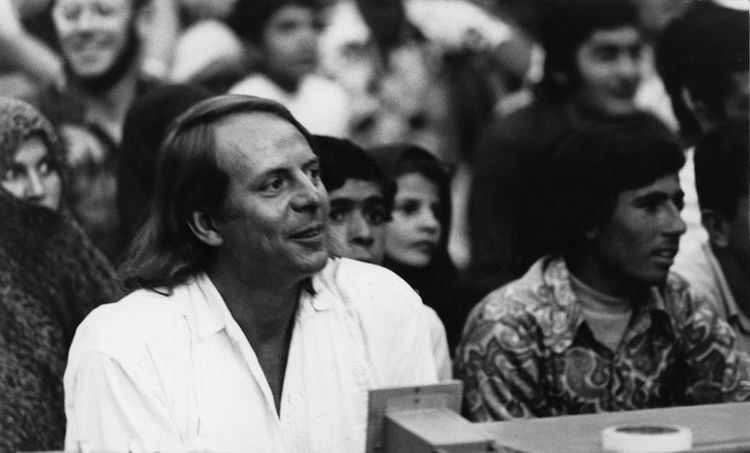 | ||
Karlheinz stockhausen japan f r kommende zeiten 1968 1970
Für kommende Zeiten (For Times to Come) is a collection of seventeen text compositions by Karlheinz Stockhausen, composed between August 1968 and July 1970. It is a successor to the similar collection titled Aus den sieben Tagen, written in 1968. These compositions are characterized as "Intuitive music"—music produced primarily from the intuition rather than the intellect of the performer(s). It is work number 33 in Stockhausen's catalog of works, and the collection is dedicated to the composer's son Markus.
Contents
History
Unlike the fifteen texts of Aus den sieben Tagen, which were all written in a short span of time, the seventeen components of Für kommende Zeiten were written in four groups of texts, over a period of two years.
The first five pieces were written in August 1968 (the fourth text, Über die Grenze on 13 August), as examples for the students in Stockhausen’s composition seminar at the Darmstädter Ferienkurse. The sixth text, Intervall, was written more than a year later, on 22 September 1969, at the Couvent d'Alziprato in Corsica, for Henry-Louis de La Grange and Maurice Fleuret. The seventh, eighth, and ninth texts were written in February 1970, during a three-week stopover Stockhausen made in Bali, on his way to Japan for Expo '70 in Osaka. The remaining eight texts were composed on the return trip from Osaka, between 4 and 7 July 1970, during another three-week pause in Ceylon (Stockhausen 1978, 167).
The first of the pieces to be premiered was Übereinstimmung, performed in London on 20 May 1970 by Gentle Fire (at that time its title was Annäherung) (Kurtz 1992, 254). A little over two years later Gentle Fire also gave the first performance of Spektren at the Shiraz Arts Festival on 4 September 1972, in the context of a series of concerts featuring Stockhausen's music. Two days later in the same concert series, Kommunikation was premiered by another English group, Intermodulation (Stockhausen 1978, 158), though another source says it was on 4 September and by Gentle Fire (Kurtz 1992, 254).
The piano duo Intervall was premiered in London by Roger Woodward and Jerzy Romaniuk on 5 May 1972, and Ceylon was first performed by the Stockhausen Group at the Metz Festival on 22 November 1973 (Kurtz 1992, 254; Stockhausen 1978, 167).
Analysis
The seventeen constituent pieces are:
- Übereinstimmung (Unanimity), for ensemble (originally titled Annäherung [Approximation])
- Verlängerung (Elongation)
- Verkürzung (Shortening)
- Über die Grenze (Across the Boundary), for small ensemble
- Kommunikation (Communication), for small ensemble
- Intervall (Interval), for piano duo, four-hands
- Außerhalb (Outside), for small ensemble
- Innerhalb (Inside), for small ensemble
- Anhalt (Halt), for small ensemble
- Schwingung (Vibration), for ensemble
- Spektren (Spectra), for small ensemble
- Wellen (Waves), for ensemble
- Zugvogel (Bird of Passage), for ensemble
- Vorahnung (Presentiment), for 4–7 interpreters
- Japan, for ensemble
- Wach (Awake), for ensemble
- Ceylon, for small ensemble
Some of the texts of Für kommende Zeiten provide more specific performance details about elements and processes than the texts from Aus den sieben Tagen do (Griffiths 1977, 639). Intervall, for example, is scored for piano duo, four-hands, and is quite explicit about the course the music is to follow, while Japan includes a written-out melodic formula and Ceylon specifies a rhythmic pattern for the Kandy drum. Beyond what is written in the score, Stockhausen prepared a form scheme for the first performances of Ceylon—something he never did for any other of his text compositions. When asked if it might not be somehow "cheating" in a piece of intuitive music to prepare so much in advance, Stockhausen replied, "Oh, no! It's not. It helps." Nevertheless, these details actually make the later text pieces more difficult to play, because "they give more mental work to do" and, "because the mental activity of the musicians normally leads to products which relate to music which they know, which is similarly subdivided or organized", they become unable to play intuitively (Stockhausen and Kohl 1985, 38–39).
In spite of their primarily verbal nature, there is evidence that these seventeen pieces should be regarded as serial compositions (Kohl 1981, 227).
Discography
In chronological order of recording:
